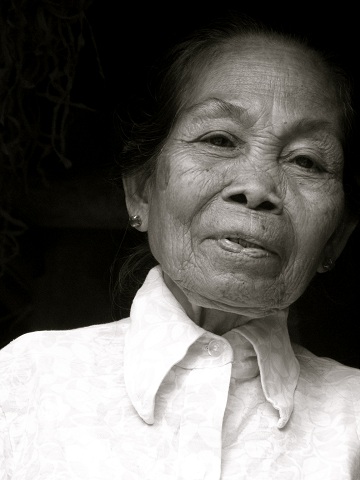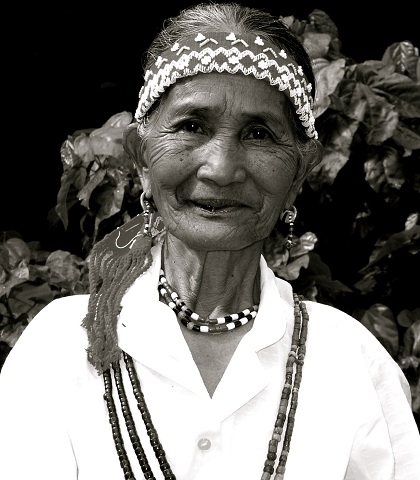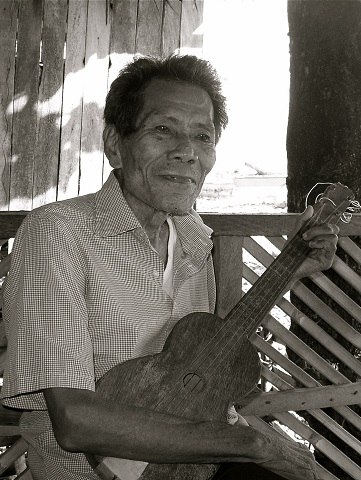Filtered By: Lifestyle
Lifestyle
Grace Nono's 'Song of the Babaylan' celebrates our islands' healers
By SYLVIA L. MAYUGA
How many brilliant singers who also happen to be scholars do you know? Only one is on my list so far – Grace Nono. Take her two latest exploits: completing course work for a PhD in ethnomusicology at New York University, and writing the formidable new book, “Song of the Babaylan: Living Voices, Medicines, Spiritualities of Philippine Ritualist-Oralist Healers.”

Cebuano-Visayan Sinuog leader Titang Diola. Photos by Grace Nono
She hopes this book will “intervene in the increasing loss of ancestral memory,” for Filipinos “to envision a future where multiple voices are heard, and change honors and includes what came before it.”
Meeting the babaylan
Writing about how the book began, we meet Grace as a musical only child raised in a farm surrounded by woods and rivers, declaring that she wanted “to be a priest.” Told that only males could do that, her mother sent her to the Philippine High School for the Arts instead.
In idyllic Mt. Makiling came her “first explicit awareness of the babaylan.” Not only did this healing priestess “mesmerize” 15-year old Grace and become the subject of her senior thesis, the babaylan stayed a silent presence in her life.
Next, working for a Humanities degree at the UP, Grace found herself deeply dissatisfied with “learning more about Western civilization than my own people,” feeling “a hunger I could not yet identify.” Meanwhile, she had become a professional singer with a growing following, mystified when she suddenly dropped out of sight. Wearied by the “senselessness” of her “mimicry” of Western music, she had gone home to Mindanao.
There she joined a trip to the mountains connecting her home province, Agusan, with Davao and Bukidnon, straight into a life-changing moment. On a chance encounter, she heard “Philippine sung oral traditions that I had not known existed” and met her first living babaylan. “I took close notice of [her] peaceful countenance, matched in intensity only by the ecstatic chants of the village singers. All this inspired me to sing again, thus commencing my long drawn-out study with oral singers, several of whom are babaylan,” she recalls.

Grace Nono in a drape by Narda Capuyan. Photo by Neal Oshima
Ancient music
Grace Nono’s rebirth from the blues to a chanter in ancient tradition brought her back to the UP, earning a master’s degree in Philippine Studies. Her masteral thesis became her first book, “The Shared Voice: Oralist Narratives from the Philippines.” Meanwhile the artist was alive and well. In the early ‘90s she released her first musical album – Tao Music – celebrated by musical cognoscenti for its haunting strains of something lost yet so familiar.
Three years later, she released her second album, “Opo” – with traditional instruments, indigenous rhythms and folk lyrics resonating with digital technology and synthesizers the critics called “world music.” Its seven Katha awards was heady stuff, but this artist stayed grounded. “I’m not on a romantic crusade to change the world,” she told the International Herald Tribune in an interview; she wanted to “evolve with these ancient forms."
And so she did. From 2004 to 2009, supported by the Institute of Spirituality in Asia, Grace traveled the archipelago in between performances here and abroad, hunting for surviving babaylan to tell her about their lives and teach her their sacred songs, some of which the spirits allowed her to learn and sing.
The emissaries
The ten babaylan Grace selected now transport us back to our ancestors’ world, where we glimpse an ancient worldview before it was marginalized as “superstition”, “idolatry” and “devil worship.”
 And what might this “devil worship” be? Why, it was seeking the favor of the spirit world to cure illnesses of body and spirit, grant rain and good harvests, safe journeys, victory over enemies, a peaceful death, and glimpses of the future in a harmony of being.
And what might this “devil worship” be? Why, it was seeking the favor of the spirit world to cure illnesses of body and spirit, grant rain and good harvests, safe journeys, victory over enemies, a peaceful death, and glimpses of the future in a harmony of being.
The babaylan’s gift of trance made her an emissary to the spirit world, and so she found herself on a direct collision course with the white male colonizer whose aggressive “Christianity” was threatened by her leadership. The feeling was mutual.
In trance and song, babaylan in Cagayan, Bicol, Pangasinan, Bohol, Iloilo cried for their people to resist the White Man. So they were hounded, arrested and driven underground, their followers terrorized. The brave men who stepped forward to replace them fought and died in resistance.
“Invocation,” the first chapter of “Song of the Babaylan,” recalls this eclipse of a people’s soul like a long, sorrowful prayer. But as the book goes on to record the new forms the ancestral spirit has taken in the present day, it slowly rises to new song.
 In chant and song, story-telling and conversation recorded in text, photos, art and voice in a CD, we meet the Kalinga andadawak, the Ibaloi mambunong, the Maguindanao patutunong, the Manobo baylan, Camiguin’s meriko, the Ibanag mangilu, the Tagbanua babalyan, the Cebuano maninuog, the matremayo of Batangas’s subli, and the T’boli tau m’ton bu still fulfilling their ancient healing role.
In chant and song, story-telling and conversation recorded in text, photos, art and voice in a CD, we meet the Kalinga andadawak, the Ibaloi mambunong, the Maguindanao patutunong, the Manobo baylan, Camiguin’s meriko, the Ibanag mangilu, the Tagbanua babalyan, the Cebuano maninuog, the matremayo of Batangas’s subli, and the T’boli tau m’ton bu still fulfilling their ancient healing role.
Noting the hybrid blends of animism with Christianity and Islam, and some babaylan now working in tandem with Western medicine, Grace offers a profound insight into the central role of voice and ear in the babaylan healing: “The babaylan’s voice [is] a site for the gathering of voices – spirit, babaylan, human – in the ongoing performance of human-spirit relationships, the state of which affects health, illness and healing.
“...all these additionally point to the babaylan’s voice as generated by a self that is permeable and expandable, i.e. predisposed to merging with other selves – spirits in the context of mediumistic or waking trance, and humans in the act of performing shared oral/aural traditions...
 “...the notion of a shared self or kapwa was described by sikolohiyang Filipino scholar Katrin de Guia as ‘the core of Filipino personhood. [It] extends the ‘I’ to include the Other [and] bridges the deepest individual recess of a person with anyone outside him or herself, even total strangers.’
“...the notion of a shared self or kapwa was described by sikolohiyang Filipino scholar Katrin de Guia as ‘the core of Filipino personhood. [It] extends the ‘I’ to include the Other [and] bridges the deepest individual recess of a person with anyone outside him or herself, even total strangers.’
“To these human strangers I add beings in different dimensions – spirits, land, creation in general – all of which participate in a sacred relationship that is made audible by voice. Herein lies a conception of voice as relationship between human and spirits, spirits and spirits, humans and humans.”
Aware of nay-saying Western scholars, Grace stares Enlightenment tradition in the eye, on the side of spirit, dreams and visions.
She presents the Filipino as an antipode to those who would deny the existence of spirit, with the historian of mythologies Prospero Covar defining Filipino personhood as a “vessel filled with spirits” and holistic thinker Serafin Talisayon citing three world surveys ranking the Filipino “as the highest in religiosity and spirituality.”
There’s far more for all kinds of Filipinos to learn in “Song of the Babaylan” – from doctors and nurses to theologians, ecologists and artists. Everyone with a stake in life would do well to rediscover the babaylan, an emissary to multiple dimensions of reality and a measure of our people’s very old soul. — BM, GMA News
Grace Nono’s rebirth from the blues to a chanter in ancient tradition brought her back to the UP, earning a master’s degree in Philippine Studies. Her masteral thesis became her first book, “The Shared Voice: Oralist Narratives from the Philippines.” Meanwhile the artist was alive and well. In the early ‘90s she released her first musical album – Tao Music – celebrated by musical cognoscenti for its haunting strains of something lost yet so familiar.
Three years later, she released her second album, “Opo” – with traditional instruments, indigenous rhythms and folk lyrics resonating with digital technology and synthesizers the critics called “world music.” Its seven Katha awards was heady stuff, but this artist stayed grounded. “I’m not on a romantic crusade to change the world,” she told the International Herald Tribune in an interview; she wanted to “evolve with these ancient forms."
And so she did. From 2004 to 2009, supported by the Institute of Spirituality in Asia, Grace traveled the archipelago in between performances here and abroad, hunting for surviving babaylan to tell her about their lives and teach her their sacred songs, some of which the spirits allowed her to learn and sing.
The emissaries
The ten babaylan Grace selected now transport us back to our ancestors’ world, where we glimpse an ancient worldview before it was marginalized as “superstition”, “idolatry” and “devil worship.”

Tagbanua babalyan Nenita Lasting
The babaylan’s gift of trance made her an emissary to the spirit world, and so she found herself on a direct collision course with the white male colonizer whose aggressive “Christianity” was threatened by her leadership. The feeling was mutual.
In trance and song, babaylan in Cagayan, Bicol, Pangasinan, Bohol, Iloilo cried for their people to resist the White Man. So they were hounded, arrested and driven underground, their followers terrorized. The brave men who stepped forward to replace them fought and died in resistance.
“Invocation,” the first chapter of “Song of the Babaylan,” recalls this eclipse of a people’s soul like a long, sorrowful prayer. But as the book goes on to record the new forms the ancestral spirit has taken in the present day, it slowly rises to new song.

Kalinga andadawak Aragoy Tumapang
Noting the hybrid blends of animism with Christianity and Islam, and some babaylan now working in tandem with Western medicine, Grace offers a profound insight into the central role of voice and ear in the babaylan healing: “The babaylan’s voice [is] a site for the gathering of voices – spirit, babaylan, human – in the ongoing performance of human-spirit relationships, the state of which affects health, illness and healing.
“...all these additionally point to the babaylan’s voice as generated by a self that is permeable and expandable, i.e. predisposed to merging with other selves – spirits in the context of mediumistic or waking trance, and humans in the act of performing shared oral/aural traditions...

Camiguingnon meriko or mamumuhat Francisco Awitin
“To these human strangers I add beings in different dimensions – spirits, land, creation in general – all of which participate in a sacred relationship that is made audible by voice. Herein lies a conception of voice as relationship between human and spirits, spirits and spirits, humans and humans.”
Aware of nay-saying Western scholars, Grace stares Enlightenment tradition in the eye, on the side of spirit, dreams and visions.
She presents the Filipino as an antipode to those who would deny the existence of spirit, with the historian of mythologies Prospero Covar defining Filipino personhood as a “vessel filled with spirits” and holistic thinker Serafin Talisayon citing three world surveys ranking the Filipino “as the highest in religiosity and spirituality.”
There’s far more for all kinds of Filipinos to learn in “Song of the Babaylan” – from doctors and nurses to theologians, ecologists and artists. Everyone with a stake in life would do well to rediscover the babaylan, an emissary to multiple dimensions of reality and a measure of our people’s very old soul. — BM, GMA News
More Videos
Most Popular



